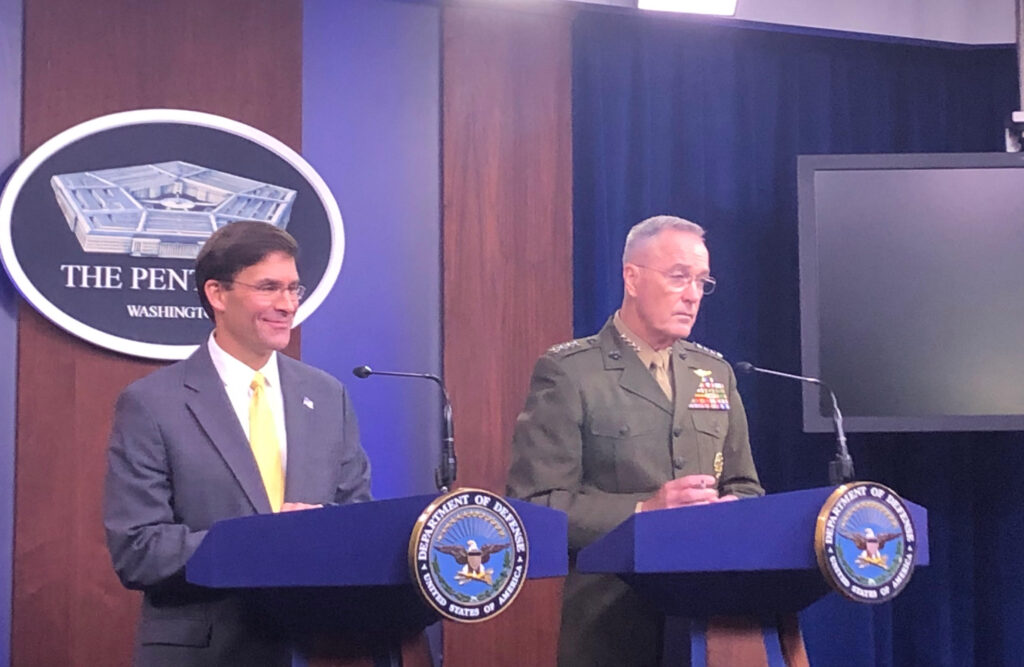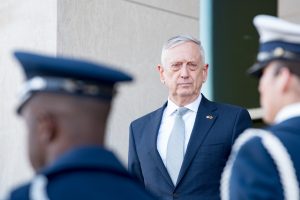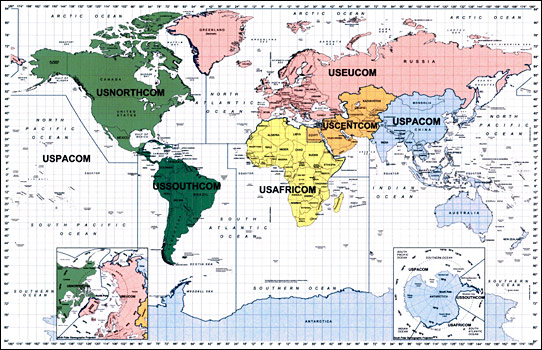Transparent & Apolitical: SecDef Esper’s Pledge
Posted on

Defense Secretary Mark Esper and Joint Chiefs Chairman Gen. Joseph Dunford in the first televised Pentagon press briefing in over a year.
PENTAGON: Not five weeks after his confirmation as Secretary of Defense, Mark Esper stepped up to the Starship Enterprise-style lecterns in the remodeled Pentagon press room for the first televised briefing there by any official in over a year. In reviving the long tradition of public briefings, he kept a pledge he made on his first day in office.
“I’m especially pleased that the Chairman and I can spend some time with you all here today,” Esper said, standing side by side with the outgoing Chairman of the Joint Chiefs of Staff, Gen. Joseph Dunford. “I intend to do these briefings to maintain an open dialogue about the department’s activities. Our head of public affairs and a representative from the Joint Staff will also begin holding regular press briefings.”

Defense Secretary Jim Mattis
That would be a return, in one small way at least, to pre-Trump normality. Trump’s first Defense Secretary, Gen. James Mattis, was widely admired by the media but rarely spoke to them. After Mattis’s sudden departure, his interim successor, Deputy Secretary Patrick Shanahan, avoided formal pressroom briefings altogether before stepping down over a family scandal.
But Esper, unlike either Mattis — a career Marine — or Shanahan — a career Boeing executive — has spent his life in and around the government: in the Pentagon, in the defense industry, and on Capitol Hill. As an experienced DC insider, Esper is the kind of quiet, politically moderate technocrat that was long seen as the ideal of public service, albeit denounced by a some these days as embodying a corrupt “deep state.”
Pressed repeatedly to comment on President Trump’s rhetoric, America’s growing political divides, or the politicization of the military itself, Esper stood firm for the principle that the Pentagon should be apolitical.
“My commitment is to keep this department apolitical, and I believe the best way to do that begin with the Chairman and I behaving in an apolitical way,” Esper said. “From there, the leadership that we demonstrate, the values we emulate, work their way throughout the force.”
“Of course, we have rules and regulations throughout the services that say you can’t wear political items on your uniform, etc. etc.” Esper added. “We’ll continue to enforce those.”
(That presumably means no more troops wearing red Make America Great Again hats at Trump speeches on military bases, among other things).
“Notwithstanding any specific incidents,” added Gen. Dunford, “I’m incredibly proud of the professionalism of our men and women in uniform, and with very few exceptions they have conducted themselves in a manner very consistent with our ethos, with our values.
“It has been a very politically turbulent period of time,” Dunford said, “yet almost 80 percent of people still have trust in the United States military as an institution.”
Esper added that “we are regarded by society very highly… but it’s a fragile thing, we have to safeguard it. We can safeguard it by practicing, on a day-in, day-out basis, our professional values.” He made the same point at the Naval War College yesterday in a speech, so it’s clearly a theme he is hammering away at.

The military’s geographical Combatant Commands (COCOMs).
Dangerous World
For the rest of the briefing, Esper and Dunford dealt with an outpouring of questions from a pent-up press corps on a score of subjects, where both men carefully hewed to long-established talking points. There’s a certain ritual character to these events:
- No, the US is not now withdrawing from Afghanistan, and any future drawdown depends on the progress of negotiations and the decline of violence.
- No, the US does not seek conflict with Iran, and the reduction in incidents in the Gulf suggests the build-up there is doing its job of deterrence.
- No, Turkey cannot get back into the F-35 stealth fighter program just by warehousing its new Russian-made S-400 anti-aircraft systems and promising not to use them.
- No, the recent collapse of intelligence sharing between Japan and South Korea has not hindered military operations, but it’s definitely a disappointment and both nations should work to reconcile.
- No, the Pentagon cannot made do with the ad hoc spending measures called Continuing Resolutions: Congress needs to pass proper policy and appropriations bills on time, by October 1st.
The one nugget of genuine news at the press conference: a peek inside the bureaucratic grind of bringing the Defense Department’s disparate fiefdoms together after months without a strong civilian leader.
“We have modified our battle rhythm,” Esper said, using military jargon for how a staff functions day to day. “Every Monday, all of the department’s senior leaders — uniformed and civilian — are now meeting twice, in separate sessions, as a leadership team to ensure our priorities are aligned and to measure progress towards implementing the National Defense Strategy.”
That’s the work of Mattis’s 2018 NDS, whose emphasis on working closely with foreign allies and partners to counter Russian and Chinese aggression sits uneasily alongside Trumpian populism. Esper has already visited both NATO and Asian allies. Both Dunford and his successor as Chairman, former Army Chief of Staff Gen. Mark Milley, are committed to working closely with allies and partners around the world..
“Our policy team has been fully integrated into our planning processes and is leading the NDS reviews, exercising civilian control over those efforts,” Esper said.
On the military side, Dunford said, “we’re adapting how we plan, how we support the secretary to make decisions, how we prioritize and allocate resources, and how we are developing tomorrow’s capabilities.
“We’ve shifted from a traditional focus on operational plans for specific contingencies” — that is, in specific regions — “to plans that are globally oriented on each of the challenges addressed in the NDS: China, Russia, Iran, North Korea, and violent extremism,” Dunford said, hitting a strategic theme he’s hammered home for years. “I’ve also scheduled a series of globally integrated exercises with participation from across the US Government interagency to refine our plans and assist the secretary in making decisions…. We’ve changed the way we prioritize and allocate resources across the combatant commands to better align with the National Defense Strategy…. We’ve fully integrated our allies and partners.”
That’s a new battle rhythm.
Subscribe to our newsletter
Promotions, new products and sales. Directly to your inbox.
